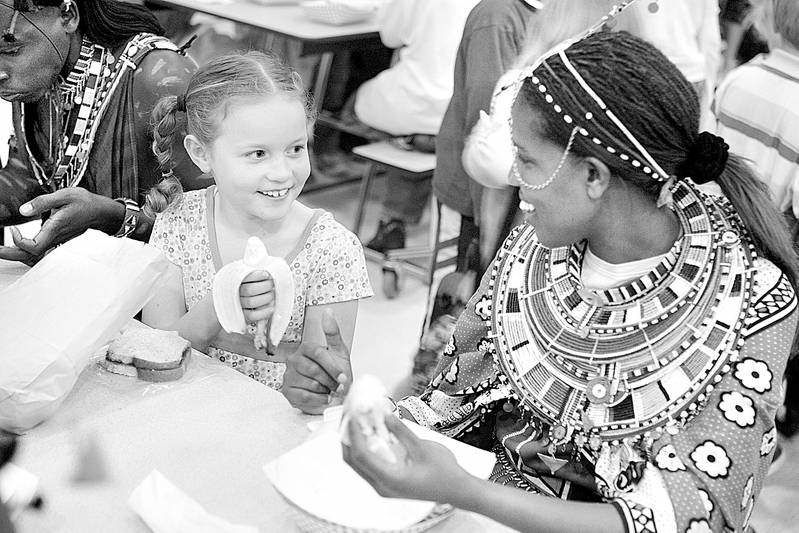Cultural dance, human touch
Published 5:00 am Wednesday, October 10, 2007

- Third-grader Hannah Penuel, 8, talks with Friends of Sironka Dance Troupe member Annah Monirei during lunch. I hope they can understand that even though we look different, even though we are from different parts of the world we can all understand one another, said Nicholas Sironka, who founded the dance troupe.
It didn’t sound like much learning was taking place as drums pounded and children clapped Monday in the Lava Ridge Elementary gym in Bend. But as students watched a dance troupe from Kenya perform traditional music, they were getting lessons that may last a lifetime.
“Some of these students will never have the opportunity to travel to Africa,” said Lisa Butler, the president of the Lava Ridge parent-teacher association. “So we wanted to bring a portion of it to them.”
The Friends of Sironka Dance Troupe has dancers who represent the Maasai tribe and the Luo tribe of Kenya. The group was formed in 2002 and has visited the United States several times. The troupe is in the midst of a 2½-month trip through the United States. After performing in a variety of locations on the West Coast, the dancers will head east to Maryland and Pennsylvania this week.
The dance troupe also visited High Lakes and Highland elementaries and High Desert Middle School in Bend, as well as performing at local churches and at Central Oregon Community College.
Butler learned that the dance group would be visiting the area through Sara Wiener, who works with Nomad Charities, a Bend-based nonprofit that works to improve life for marginalized people in Kenya.
“I knew we had to make it happen,” Butler said.
At 10:30 a.m. Monday, third-, fourth- and fifth-graders filed into the Lava Ridge gym. A few spotted one of the Maasai performers adjusting his outfit in the corner and turned to their friends with excitement.
“We want students to simply be aware of other people,” Butler said. “There are other cultures, other ways of living daily life.”
Wearing colorful outfits embellished in some parts with sequins and beading, the dancers marched through the crowd of students. The female dancers moved their shoulders so that their necklaces shook, and the men carried shields and canes.
“We celebrate life,” Nicholas Sironka said. Sironka, who started the dance troupe and who taught Maasai culture and batik art at Whitworth College in Spokane on a Fulbright grant in 2000, explained to students that many of the tribes in Kenya wear red because red is the color of life.
After each number, Sironka shared information about the area of the world where he and the dancers come from. He also used the time to teach lessons to students, urging them to say good morning to their parents each day and remember to speak one at a time.
The Luo dancers presented a song about fishing, and Sironka invited students and teachers from the audience to dance with Florence Muga, who wore a skirt that looked like a fish’s tail.
“Dance like you like fish,” Sironka urged the students. Most giggled and shimmied their hips nervously.
The Maasai also performed a song traditionally sung when the men are looking for good pasture and the women are asking the cows for more milk. The dance culminated in a jumping contest.
Students even learned a bit of Swahili, as Sironka taught them to say hello. He also pointed out that anyone who had ever said Hakuna Matata was already a Swahili speaker.
Students were enraptured by the performance.
“I thought it was amazing,” said Caitie Heirich, 9. “My favorite part was them singing and dancing.”
Heirich’s friend from the fourth grade, Chloe Baker, 9, was most impressed with the dancers’ outfits.
“I thought they were really cool and colorful,” Baker said.
Sironka hopes to stay in touch with some of the students as well. He said that if students have questions, they can give them to their teachers, who will have Sironka’s e-mail address. He will write them back and tell them about life in Kenya.
“The focus is not just on singing and dancing,” Sironka said. “We want to uplift the standards of living for people in Kenya with the money we make on these tours and with our crafts.”
Sironka said the heart shown by his dancers is their greatest quality.
“It’s not for the material things,” he said. “Now, we can help kids (in Kenya) go to school and get clothing.”
After the assembly, the dance troupe spent lunchtime with students and then spent the afternoon in workshop classes, teaching the children hair-braiding, bead-making and batik art.
For Sironka, his greatest hope is that the students he meets will remember that even though he and his dance troupe look different from most people in Bend, they are still humans with something to offer.
“I hope they can understand that even though we look different, even though we are from different parts of the world … we can all understand one another,” he said. “If they grow up with that in mind, they can be accepting of one another and the world can be a better place.”








